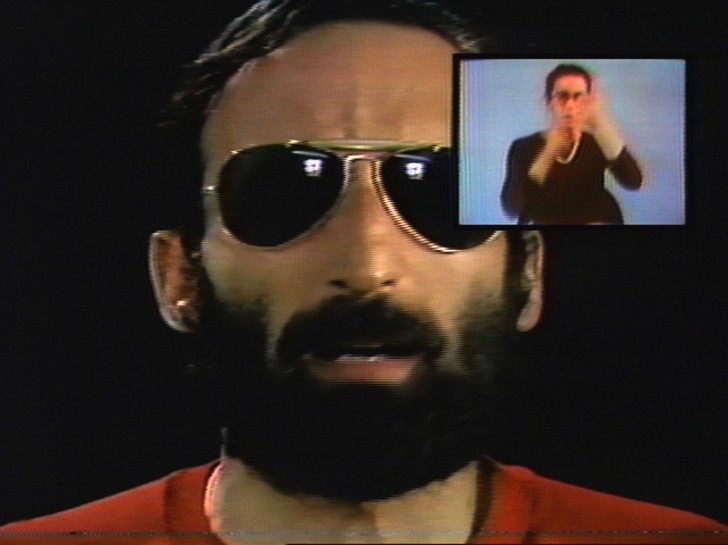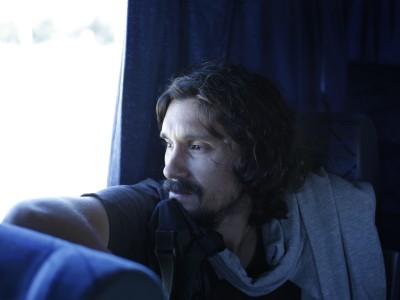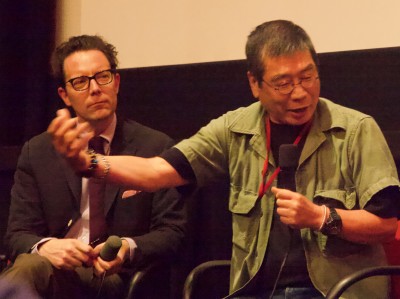
The Poetic Semiotics of Peter Rose with introduction by Peter Rose and Haden Guest. Introductions to individual works and excerpt of live performance also by Peter Rose.
Transcript
John Quackenbush 0:00
February 18 2013, the Harvard Film Archive screened works by Peter Rose. This is the introduction by Haden Guest and filmmaker Peter Rose. And now Haden Guest.
Haden Guest 0:15
[INITIAL AUDIO MISSING] –new languages to challenge and expand the world of the realm of habitual perception. It's a really great honor to welcome Peter Rose here to the Harvard Film Archive from Philadelphia, where he is a professor at the School of Film in Philadelphia's renowned University of the Arts. Please join me now in welcoming Peter Rose.
[APPLAUSE]
Peter Rose 0:49
First of all, I think a lot of you guys should maybe move over so you're in the middle, because I spent a lot of time working on sound, and I think you'll have a better experience. Just a suggestion.
Alright, we're gonna look at six works. And it's kind of an odd conjunction. My work is, in some ways, all over the place. I've done a lot of work about space, I've done a whole body of work about light about language, I'm going to show you what kind of a sampling of each of those. Much of this will be worked from... ago—with a couple of more recent examples. If you want to see the more recent work, then I invite you to Emerson tomorrow night, where I'll be showing some of the latter work.
I've been making work for about forty-five years. I've made, I don't know, maybe about forty pieces. And I got into film in a kind of an incidental way. I was studying mathematics, and got to a certain point where I couldn't figure out what the hell I was proving. It was very interesting. I had no idea what it meant, it was so abstract. And I happened to go to a series of lectures by a guy named Slavko Vorkapich, who was this legendary montage artist who gave a series of lectures that was at USC, and then again, at Modern Art, about sort of the basic structure of film. Very interesting. And I said, “Hey, this is interesting!” As a mathematician, you can build things in time and space with film, which are quite tangible and concrete. And I thought maybe it might be interesting to apply a kind of mathematical sensibility to the idea of building experiences in time. So I began playing in 16. I was playing with rhythm. I was interested in the idea of rhythm. And if there’s any animators amongst you, I was shooting something on three’s—three frames the same—so you got this kind of staggered thing. And quite by accident, I superimposed something going in three against something that was going in four. Now, if you know music, that's a polyrhythm. Right? So [TAPS OUT THE RHYTHM] It’s three against four. So we understand that as an oral rhythm. I wondered if somehow this visible structure might have some relation to it. Could you make a visual analogy for a musical form? So I made a film called Incantation. Technically, it may be worth noting, this was shot in regular 8 millimeter, which did not have a frame counter—for those of you who know about these kinds of things—no frame counter, and you'd take these little twenty-five-foot rolls and you put them in, you'd count frames, and you flip it over and you'd shoot it and you do that, you know, like five or six times and hope all the images lined up. And so this film is an experiment in various forms of visual polyrhythm. I blew it up to 16 and added a soundtrack, which I think is worth noting. One of the animating rhythms in this film was my breath. When I was trying to figure out what kind of tempo to use, I thought, Oh, breath, that seems like a good place to start. So the visual structure has implicit in it a breathing rhythm. So I chose a piece of music which had a breathing rhythm, which was a piece of Islamic liturgy. I note that one could never have foreseen that it would have any political or cultural implications, right. I just thought it was beautiful music. So listen to it in that light. So we'll start with Incantation.
John Quackenbush 4:17
And now filmmaker, Peter Rose.
Peter Rose 4:21
–with this idea of time delay and found you could do interesting things to space and time if you play with this. Now, of course, a lot of people were playing with grid structures, you know, I mean, it was in the air. Cubism certainly sort of operates this way, so it's not unprecedented, but it led to some interesting ideas. And over time, I began to realize that many of these experiments seem to have some connections with each other. I didn't start out to make this film I'm about to show you. I don't work by scripts. I don't have any idea what the hell I'm doing most of the time. I just fool around and then figure out what it means later. So this film came out of that. It came out of six little experiments which I realized ultimately, were about something. So I realized that the probably the hippest way to talk about what something's about is not to talk about it, but to give you the tag words. So if you were to look this up and check out the tag words—not that I've done this—it would say: [?orhez?], map-making, astronomy, the sky, time, the musical structures of Steve Reich, Monet, Breugel, total solar eclipses, suspension bridges, jetties, journeys, fathers, freedom, death, journeys, enclosures and liberations, near and far, crossing over. I showed this film to Ornette Coleman once—whose music you'll hear at the end—and he had a really beautiful way of talking about this film, very gnomically. He said, “Oh, I see what this film is about.” He said, “This is about the open.”
John Quackenbush 6:08
Now, filmmaker, Peter Rose.
Peter Rose 6:14
So one question is why it has to end that way. And I just realized there’s a very nice connection between this film and Pneumenon and The Man Who Could Not See Far Enough. I couldn't leave language in the dark at the end. I just felt it was too depressing, you know, consciousness emerges then it disintegrates and goes into death. I mean, how can you resurrect consciousness in some other dimension? I'm interested in sort of other dimensions. Pneumenon is about that back and forth between two and three and four dimensions. And how could you have language in another dimension? Well, back when one made films, when you sent the film to a lab, they’d write on it at the end. And of course, you can never read it, because you're seeing it a frame at a time. So “Oh! Why don't I write something on the film?” So there's a whole other message there, but it exists in another space-time continuum, and you can't read it now. Actually, I'm not going to tell you it says. You'd have to look at the film. And it's a very beautiful sort of poem there. But it has to be seen in this other way. The only thing you understand is the exclamation point at the end. Tomorrow or whenever, Wednesday, maybe I'll run the successor to this film in which is an entire film made by writing on the film and playing with sort of the materiality of the image in various ways.
Any questions about this before we move on to something...? Alright. Yes.
[INAUDIBLE AUDIENCE QUESTION]
Oh, a lot of improvisation. Yeah. And, you know, it's weird, The Man Who took me seven years and was an agony. And after I was done, I said, I want to do something that's cheap, fast and out of control? Isn’t that the Errol Morris film? So I wrote this whole thing in one session, and just sat down and did it. And it wasn't a lot of different– A little bit of editing, but then the thing at the end is a duet for voice and dishwasher, and that was improvised. That was with a guy named Jim Meneses who’s a very interesting percussionist. I mean, I think the film, you know, it's part of a whole suite of works I did called Vox!, which is about language, and that's a subject that has interested me in various ways. Sometimes I see language as an adversary to image. On the other hand, clearly, you can do things with it that are kind of fun. So I think what I want to do before we get into the next thing is talk about the whole idea of language. And in particular, its relation to a kind of body tongue, which is kind of a basic sematic construct that too often too freely divorced from much formal consideration, but which is quite, I think, thoroughly enmeshed in the tissue of a kind of subjectivity that lends itself to a discussion that’s both historically positioned and maybe somewhat rhetorically bounded. So let's consider what I'll call just for the moment, the residues of artifice. Now, I haven't talked about labor in a lot of these films, but that's a whole other subject. The residues of artifice. And by this, I mean a trace, a claim, an inscription, a difference that would be homologous or equivalent to what you might call the ultimate destination of dialectic, if it weren't for the fact that its own inner laws appear to be generated by the lexical indices of a kind of ontological preexistent and of course, by the inevitable paradigms of post-modernist capitalism. So if you deconstruct this and reduce it to a pre-textural mode of utterance, we find that its formerly parodicmatic level of sutrip claims a kind of ideology that sustains both a phenomenological reading and which is itself polemically encoded. So the specular anticipation of the position the spectator in their stunned gnomesis is thereby engaged by the syntactic rubric of a semiological analysis that betrays its own Lacanian roots that turgid, reified metaphoresis that reawakens an idiomimetic reverberation that oblate insip spaceship fertile and engagé notwithstanding critical heuristics whose hypostisized intrusions into species-specific spatiotemporal domains enjoined by ironic distanciation. These are substrategized dislocations of transischemic discourse. And while hermeneutic gesture is posited by an essentially tautological regrounding of cathetic instantiation may be hopelessly ambuglad, without a propadoidic gesture lexically inflamed, we are doomed to a feeble resuscitation of pathetic fallacy, an unideological dicta mori save sundry arcane pledged
redemptions of proto-ingot ergo non says a fetid planer gobo but walobinze shanti tiver dollop coponze prizbut miertly sconze idia kula pierkli maya farfa presa bundo hüt de charitekushta digrinja matato vüva van haké jasee da dhaka noka itsan proppe d’bebashe crope ne quata nieriaquatre néné sacruta mamama tookaaaah saquita soontikita katdema nomakat chikbuta tokotema akatita idia grrrata minhooshu mmmmatata sokrrrindakademanam mama sokrindakatina katamememe katutta yiakyiaké deseycha [TRAILS OFF]
[ABOVE TRANSLATION AN APPROXIMATION THAT DOES NOT REFLECT ROSE’S EVOLVING ACCENT AND NON-ENGLISH PHONETICS OVER THE COURSE OF THE PERFORMANCE]
[APPLAUSE]
John Quackenbush 12:03
And this concludes the Peter Rose program.
©Harvard Film Archive
Related film series
Explore more conversations
Lisandro Alonso

Olaf Möller

Valeska Grisebach

Kazuo Hara & Sachiko Kobayashi

